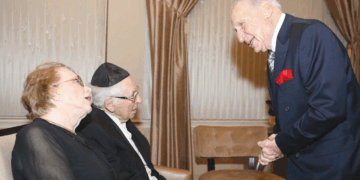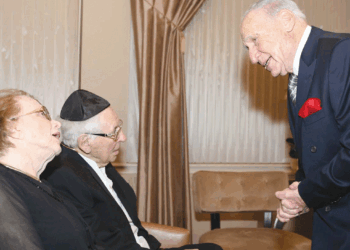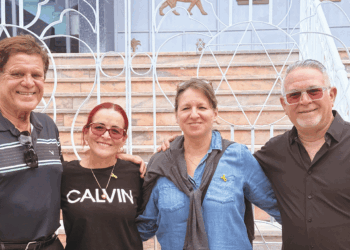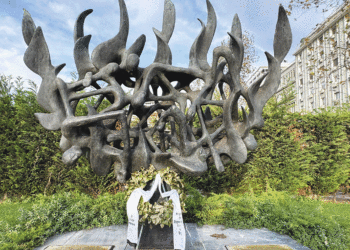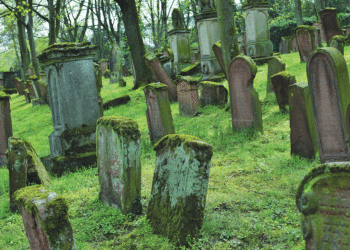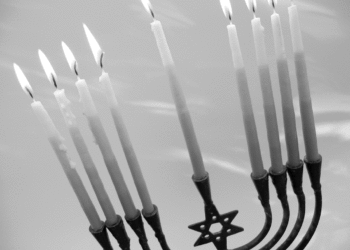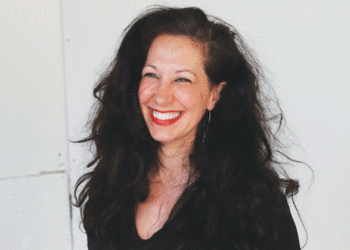by CARLA WALDEMAR
When the Nazis rolled through Czechoslovakia in 1939, they murdered its Jews, as was their grisly practice. 90 percent of the country’s Jewish population was killed, its property confiscated and communities destroyed — but not in Prague’s ghetto. After exterminating its inhabitants, the ghetto was left virtually intact, slated to be a “museum of an extinct race,” according to the Nazis’ plan.
That much is fortunate. And so is the fact that visitors can tour its four well-preserved historic synagogues from the 1500s (as well as the elaborate Spanish Synagogue of 1868), the Ceremonial Hall and arguably the most evocative cemetery in the world — well, one of two. We’ll visit the other one later.
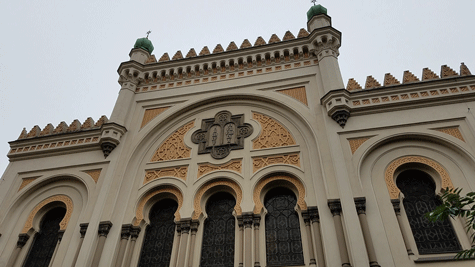
The Maisel Synagogue, a renaissance edifice of 1590 built by the mayor of the Jewish ghetto (a man so favored by the court that he didn’t have to wear yellow when he left the ghetto gates, as other Jews did) was an ornate emblem of Prague’s — and its Jews’ — Golden Age.
The Emperor allowed Jews out of the ghetto, and even permitted them to print books in Hebrew — an industry which became Prague’s claim to fame. Today the synagogue is used by the Jewish Museum of Prague to exhibit many of the 40,000 precious historic religious objects the Nazis stashed inside it, along with accounts of the history of the Jewish settlement since its start in the 10th century.
Across the street, the Pinkas Synagogue of 1535 has been turned into a memorial to the country’s murdered Jews, 80,000 of whose names are inscribed on its stark walls along with the titles of the extermination camps. Upstairs, a display of drawings of some of the 10,000 children imprisoned at the nearby Terezin camp convey a poignant message. “Here there are no butterflies,” wrote one child. “I’d like to go to a place where people didn’t get killed,” another inscribed on his drawing.
Skirting the nearby Klausen Synagogue of the 1500s is the famous Jewish Cemetery, a tiny community of 12,000 inscribed tombstones packed as tightly as an upright deck of cards. The most celebrated of them marks the grave of Rabbi Judah Loew of 1609 — he who created the Golem robot, so the legend says.
The Old-New Synagogue (built in the 13th century to replace one synagogue, then, in turn replaced by another) boasts a ribbed and vaulted medieval ceiling, while the Spanish Synagogue, a few blocks on and few hundred years younger, now acts as an exhibit space for historic Torahs and such amid the ornate Moorish splendor.
A beauty.
Then the beast. Terezin, the Gestapo’s prison, lies about an hour away. Today its victims are buried outside the walls, overseen by a giant Star of David. Inside the fortress, the first thing the eye can spot is the ironic slogan, “Work Makes You Free.” One sight the inmates never spotted, however, was the model camp facilities — which included mirrors and individual shaving sinks — built solely to impress Red Cross inspectors. Everything else is chilling, and left unrestored — no theme-park airbrushing, as some camps today are experiencing.
Back in town Leo Pavlat, director of the Jewish Museum, felt good about the current environment. Under the Nazis, then the equally-anti-Semitic Communist regime, which ended with the Velvet Revolution in 1989, teaching and practicing religion was forbidden. Owning Hebrew books was also forbidden (yet Pavlat managed to learn Hebrew in secret).
Today the government lends support to the museum’s educational mission, carrying it to school classrooms. And at last the town has a rabbi again — Pavel Maier, who came from Budapest. “We all had to face very difficult cultural problems,” Pavlat acknowledges. “Many emigrated to Israel. But now, in Prague, it’s once again possible to observe the total Jewish life — education, keeping kosher, the mikve bath. You can be 100-percent observant,” he emphasizes.
He’s launched a Jewish newspaper and radio broadcast and would like to believe the population is slowly starting to climb. Today the average age has dropped from 70-plus to 59, he says, and six Bar Mitzvas were celebrated last year.
(American Jewish World, 11.3.17)

